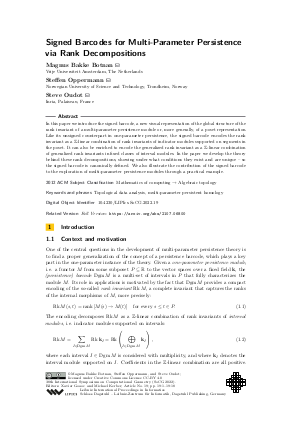Signed Barcodes for Multi-Parameter Persistence via Rank Decompositions
Authors Magnus Bakke Botnan, Steffen Oppermann, Steve Oudot
-
Part of:
Volume:
38th International Symposium on Computational Geometry (SoCG 2022)
Part of: Series: Leibniz International Proceedings in Informatics (LIPIcs)
Part of: Conference: Symposium on Computational Geometry (SoCG) - License:
 Creative Commons Attribution 4.0 International license
Creative Commons Attribution 4.0 International license
- Publication Date: 2022-06-01
File

PDF
LIPIcs.SoCG.2022.19.pdf
- Filesize: 3.43 MB
- 18 pages
Document Identifiers
Related Versions
- Full Version https://arxiv.org/abs/2107.06800
Subject Classification
ACM Subject Classification
- Mathematics of computing → Algebraic topology
Keywords
- Topological data analysis
- multi-parameter persistent homology
Metrics
- Access Statistics
-
Total Accesses (updated on a weekly basis)
0Document
0Metadata
Abstract
In this paper we introduce the signed barcode, a new visual representation of the global structure of the rank invariant of a multi-parameter persistence module or, more generally, of a poset representation. Like its unsigned counterpart in one-parameter persistence, the signed barcode encodes the rank invariant as a ℤ-linear combination of rank invariants of indicator modules supported on segments in the poset. It can also be enriched to encode the generalized rank invariant as a ℤ-linear combination of generalized rank invariants in fixed classes of interval modules. In the paper we develop the theory behind these rank decompositions, showing under what conditions they exist and are unique - so the signed barcode is canonically defined. We also illustrate the contribution of the signed barcode to the exploration of multi-parameter persistence modules through a practical example.
Cite As Get BibTex
Magnus Bakke Botnan, Steffen Oppermann, and Steve Oudot. Signed Barcodes for Multi-Parameter Persistence via Rank Decompositions. In 38th International Symposium on Computational Geometry (SoCG 2022). Leibniz International Proceedings in Informatics (LIPIcs), Volume 224, pp. 19:1-19:18, Schloss Dagstuhl – Leibniz-Zentrum für Informatik (2022)
https://doi.org/10.4230/LIPIcs.SoCG.2022.19
BibTex
@InProceedings{botnan_et_al:LIPIcs.SoCG.2022.19,
author = {Botnan, Magnus Bakke and Oppermann, Steffen and Oudot, Steve},
title = {{Signed Barcodes for Multi-Parameter Persistence via Rank Decompositions}},
booktitle = {38th International Symposium on Computational Geometry (SoCG 2022)},
pages = {19:1--19:18},
series = {Leibniz International Proceedings in Informatics (LIPIcs)},
ISBN = {978-3-95977-227-3},
ISSN = {1868-8969},
year = {2022},
volume = {224},
editor = {Goaoc, Xavier and Kerber, Michael},
publisher = {Schloss Dagstuhl -- Leibniz-Zentrum f{\"u}r Informatik},
address = {Dagstuhl, Germany},
URL = {https://drops.dagstuhl.de/entities/document/10.4230/LIPIcs.SoCG.2022.19},
URN = {urn:nbn:de:0030-drops-160276},
doi = {10.4230/LIPIcs.SoCG.2022.19},
annote = {Keywords: Topological data analysis, multi-parameter persistent homology}
}
Author Details
References
- Hideto Asashiba, Mickaël Buchet, Emerson G. Escolar, Ken Nakashima, and Michio Yoshiwaki. On interval decomposability of 2d persistence modules, 2018. URL: http://arxiv.org/abs/1812.05261.
- Hideto Asashiba, Emerson G Escolar, Ken Nakashima, and Michio Yoshiwaki. On approximation of 2d persistence modules by interval-decomposables. arXiv preprint, 2019. URL: http://arxiv.org/abs/1911.01637.
-
Magnus Botnan and William Crawley-Boevey. Decomposition of persistence modules. Proceedings of the American Mathematical Society, 148(11):4581-4596, 2020.

- Magnus Bakke Botnan, Vadim Lebovici, and Steve Oudot. On Rectangle-Decomposable 2-Parameter Persistence Modules. In Sergio Cabello and Danny Z. Chen, editors, 36th International Symposium on Computational Geometry (SoCG 2020), volume 164 of Leibniz International Proceedings in Informatics (LIPIcs), pages 22:1-22:16, Dagstuhl, Germany, 2020. Schloss Dagstuhl-Leibniz-Zentrum für Informatik. URL: https://doi.org/10.4230/LIPIcs.SoCG.2020.22.
- Magnus Bakke Botnan, Steffen Oppermann, and Steve Oudot. Signed barcodes for multi-parameter persistence via rank decompositions and rank-exact resolutions. arXiv preprint, 2021. URL: http://arxiv.org/abs/2107.06800.
-
William Crawley-Boevey. Decomposition of pointwise finite-dimensional persistence modules. Journal of Algebra and its Applications, 14(05):1550066, 2015.

- Tamal K Dey and Cheng Xin. Generalized persistence algorithm for decomposing multi-parameter persistence modules. arXiv preprint, 2019. URL: http://arxiv.org/abs/1904.03766.
- Woojin Kim and Facundo Memoli. Generalized persistence diagrams for persistence modules over posets. arXiv preprint, 2018. URL: http://arxiv.org/abs/1810.11517.
-
Claudia Landi. The rank invariant stability via interleavings. In Research in computational topology, pages 1-10. Springer, 2018.

- Michael Lesnick and Matthew Wright. Interactive visualization of 2-d persistence modules. arXiv preprint, 2015. URL: http://arxiv.org/abs/1512.00180.
- Alexander McCleary and Amit Patel. Edit distance and persistence diagrams over lattices, 2021. URL: http://arxiv.org/abs/2010.07337.
-
Nikola Milosavljević, Dmitriy Morozov, and Primoz Skraba. Zigzag persistent homology in matrix multiplication time. In Proceedings of the twenty-seventh annual symposium on Computational geometry, pages 216-225. ACM, 2011.

-
Dmitriy Morozov. Homological illusions of persistence and stability. PhD thesis, Duke University, 2008.

-
Amit Patel. Generalized persistence diagrams. Journal of Applied and Computational Topology, 1(3):397-419, 2018.

